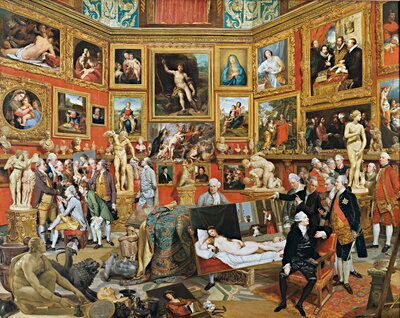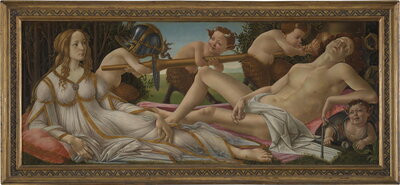On 15 November 2022, at the penultimate Fall lecture in the Modern Critical Lecture series, art historian Lisa Rosenthal discussed the gendered gaze that beholds the female nude through a series of paintings from the early modern period. The lecture began with a viewing of Johan Joseph Zoffany’s oil painting The Tribuna of the Uffizi. This painting guided the selection of the subsequent paintings and the theme of the male gaze throughout the lecture. As Rosenthal explained, the painting, in the collection of the Medici family, was a baroque work that captured the art of viewing. In the painting, a group of male art collectors are seen observing paintings from the early modern era, between the fifteenth to the eighteenth century. The gender of the viewers and their viewing subjects—many of which were female nudes—raises questions about the gendering of visual pleasure and representation.

Rosenthal began by defining key terms that are significant to understand the visual pleasure in viewing the female nude. The first term, representation, she insisted refers to a necessarily non-neutral activity shaped by conventions and ideologies of a historical period. Representation in a painting is a set of semiotically rich symbols that actively produce ideas, including ideas about gender. Further, building on Joan W. Scott’s famous essay, “Gender: A Useful Category of Historical Analysis” (1986), she asserted that men and women are conceptual categories, rather than static binaries, always mediated by culture and history, as also evident in Foucault’s readings. Here in her argument, she also invoked Derrida’s conception of différance which reflects both the difference and deference of a fixed meaning in gender categories. These re-definitions of gender contribute to a fresh understanding of male gaze as a practice of gendered visual pleasure wherein women stand as image for the active viewer—necessarily male. Rosenthal then turned to Laura Mulvey’s essay “Visual Pleasure and Narrative Cinema” (1975) wherein the film critic posited that the gaze is a “contingent operation” that carries within it the threat of displeasure rooted in the memory of the female lack. The Venus of Urbino (c. 1538) by Titian was among the first paintings to establish the conventions of the female nude (and which itself is represented in The Tribuna of the Uffizi), the female—defined by her nudity—presents herself to the empowered gaze which asserts its authority over the figure through the act of viewing. The body, languid and seemingly boneless, at once hides and draws attention to the potential displeasure of the female lack through strategic positioning of the hands. Rosenthal explained that the painting was likely a marital commission.
However, Mulvey’s singular view of the male gaze and visual pleasure is countered by Edward Snow’s “Theorizing the Male Gaze: Some Problems” (1989) in which he presents alternative modes for viewing the female nude. In Snow’s analysis, and in Rosenthal’s lecture on the male gaze, the “Rokeby Venus” (1647), a painting by Diego Velázquez, stands as a counterpoint to the previous Venus. In this representation, the misalignment of the reflection and the figure, and the consequent indeterminacy of the female gaze, opens a space for preoedipal pleasure. According to Snow, limited perspectives on the male gaze reduces the theory to “become an unwitting agent of the very forces of surveillance it wishes to oppose” and it is crucial that the “gaze resists being understood in terms” of patriarchal, ideological, pornographic motives (Snow, p. 31).
Rosenthal traced representations of the female to analyze how gender binary is subverted and genders displayed as fluid and malleable, even as its anxieties seep into these paintings. In The Horrors of War by Peter Paul Rubens (1638-1639), Venus is seen stopping Mars from going to war, a classical allegory that alluded to the Thirty Years’ War that raged then in Europe. Rosenthal argued that Venus, even as she is focused on Mars, turns her body toward the viewers for their visual consumption. However, the political context of the painting constricts the pleasure so that the desire to possess Venus also becomes here the desire for political peace.

At the same time, the gender system in the painting disrupts the achieved peace, as we note the physical differences between the male and the female body, and Venus as the ‘threat’ to the masculinity of Mars. Rosenthal explained that according to premodern medicine, the body was comprised of four humors and was defined by the balance of the liquids. In the male body, blood dominated, while in the female, black bile. Through different balancing of humors in the body, we see the transgressive possibility of gender as flexible. In the painting, as the phallic sword drips blood next to Venus, Mars faces the threat of emasculation. This threat is fully realized in Botticelli’s “Venus and Mars” (c. 1485) a comic inversion which underscores the normative force of gender. Mars is depicted in utter platitude after his union with Venus, and his armor has turned into playthings for satyrs, symbols of lust and sexuality.

The comic inversion, Rosenthal explained, is a carnivalesque topsy-turvy world which destabilizes normality. Here, Botticelli’s painting presents “a pleasurable spectacle of masculine disempowerment”. Through the comic mode patriarchal norms are reorganized and pleasures, which might otherwise be unrepresentable, are allowed to enter the viewing experience. To further her argument, she showed how stylistic choices and use of color were highly gendered and more importantly, divorced from the body of the artist.
Jumping from the early European art to the twenty-first century, she ended the lecture with a new mode of female representation in Flora Yukhnovich’s Moi Aussi je déborde (I too flow) (2017) and left the audience with the final question, “what kind of meanings would these texts generate around gender, pleasure and women artists in the twenty-first century?”